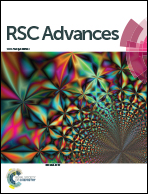A new 12L-hexagonal perovskite Cs4Mg3CaF12: structural transition derived from the partial substitution of Mg2+ with Ca2+†
Abstract
A new 12L-hexagonal perovskite Cs4Mg3CaF12 was synthesized using an open high-temperature solution method. It crystallizes in the trigonal space group R![[3 with combining macron]](https://www.rsc.org/images/entities/char_0033_0304.gif) m (no. 166) with lattice constants a = 6.2196(9) Å, c = 29.812(9) Å, Z = 3. Cs4Mg3CaF12 is changed from the cubic phase CsMgF3 by replacing 25% Mg2+ with Ca2+. The changes derived from the substitution and the structural comparison between Cs4Mg3CaF12 and other perovskites are discussed in this paper. Thermal analysis, infrared spectroscopy, and electronic structure calculations were performed on the reported material.
m (no. 166) with lattice constants a = 6.2196(9) Å, c = 29.812(9) Å, Z = 3. Cs4Mg3CaF12 is changed from the cubic phase CsMgF3 by replacing 25% Mg2+ with Ca2+. The changes derived from the substitution and the structural comparison between Cs4Mg3CaF12 and other perovskites are discussed in this paper. Thermal analysis, infrared spectroscopy, and electronic structure calculations were performed on the reported material.


 Please wait while we load your content...
Please wait while we load your content...